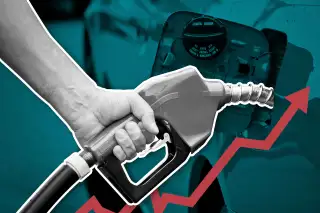Gas Prices Just Hit a 7-Year High

Gas prices in America are averaging $3.27 per gallon of regular — over $1 more than a year ago, and the highest they've been since 2014.
Prices at the pump are rising particularly steeply lately. A gallon of regular costs an extra $.10 or more over what it did one week ago in nine states (Kentucky, Indiana, Florida, Michigan, Alabama, Tennessee, South Carolina, Illinois and Delaware) and Washington, D.C., according to AAA. California drivers almost always face the highest gas prices in the nation, and they're paying well over $4 a gallon right now — an average of $4.44, at last check, compared to $3.21 a year ago.
For drivers, high gas prices today are not just painful, but probably quite confusing as well. The summer road trip season is over, and commuting is still down compared to pre-pandemic times.
That should mean that demand for gasoline remains fairly low. Indeed, demand at gas stations has fallen for the last two weeks, "in line with expectations for autumn," a blog post from the GasBuddy app reported on Monday. And when demand is low and on the decline, prices are generally supposed to fall as well — or at least not climb.
Why are gas prices so high?
Consumer demand is one factor that affects gas prices, but it's hardly the only one. According to the U.S. Energy Information Administration, 52% of the retail price of gasoline is based on how much wholesale crude oil costs. The rest of the cost comes from refining the oil, plus taxes and distribution and marketing.
Crude prices are high for a variety of reasons, though industry experts say it's mainly because OPEC+ — the Organization of Petroleum Exporting Countries, consisting of Saudi Arabia and 12 other oil-production nations, plus their allies — have decided to keep output limited.
The White House has been pressuring OPEC+ to increase oil production, which was scaled back dramatically in 2020 and still is below pre-pandemic levels. A Biden administration official said that it has instructed oil-producing countries to "do more" to address rising crude prices, and that it is "using every tool at our disposal to address anti-competitive practices in U.S. and global energy markets to ensure reliable and stable energy markets," Reuters reported.
"While we need to take steps to address short-term supply issues, we need to also keep our eye on the long term and the impact of the climate — the crisis that is — we are in the middle of and ensure that we are continuing to encourage the production and rise of renewables and the clean energy industry," White House Press Secretary Jen Psaki said in a recent press briefing.
Last week, after OPEC+ decided it would not raise production beyond an already agreed-upon level, oil prices hit a seven-year high. So it does not come as a surprise that retail gas prices in the U.S. followed by hitting a seven-year high as well.
The last time gas prices were consistently this high in the U.S. was 2014. That year, gas prices reached their peak in June with an average of $3.77 per gallon nationally. Prices steadily decreased through the fall of 2014 into winter, however, which is how things normally go.
Unfortunately for drivers, 2021 is not a normal year in many ways, and that includes gas price trends.
More from Money:
How to Inflation-Proof Your Retirement as Prices Continue to Rise
From Dresses to Dog Food, Here Are 8 Essentials Inflation Is Making More Expensive